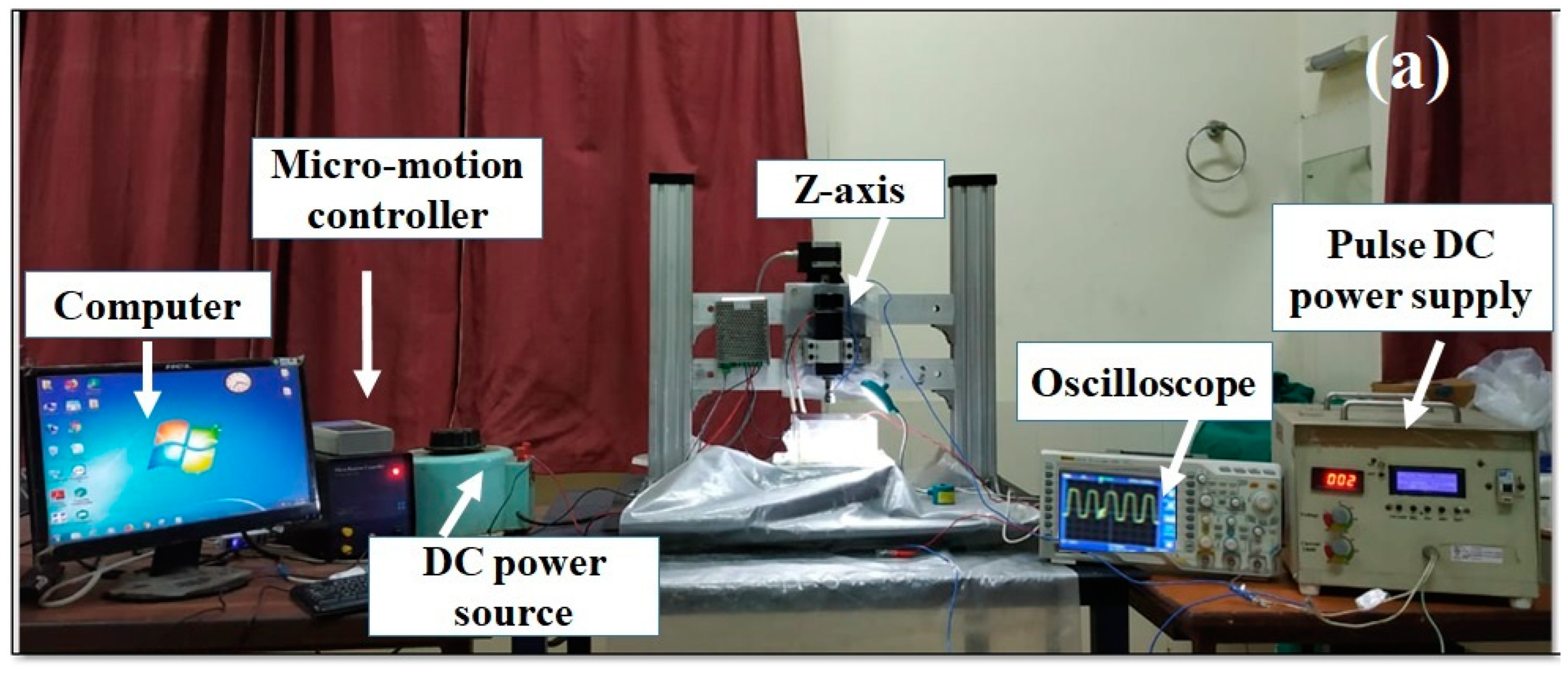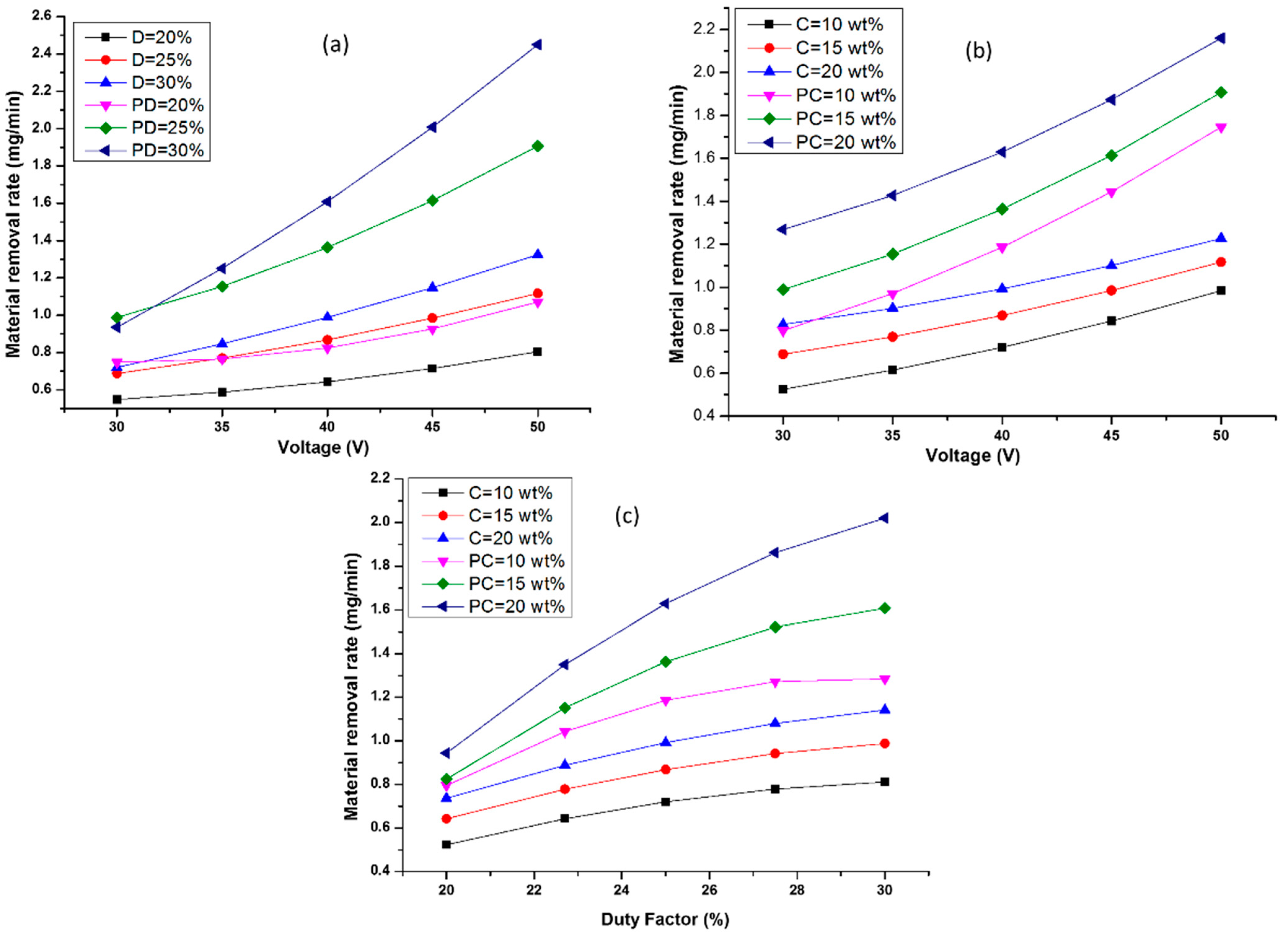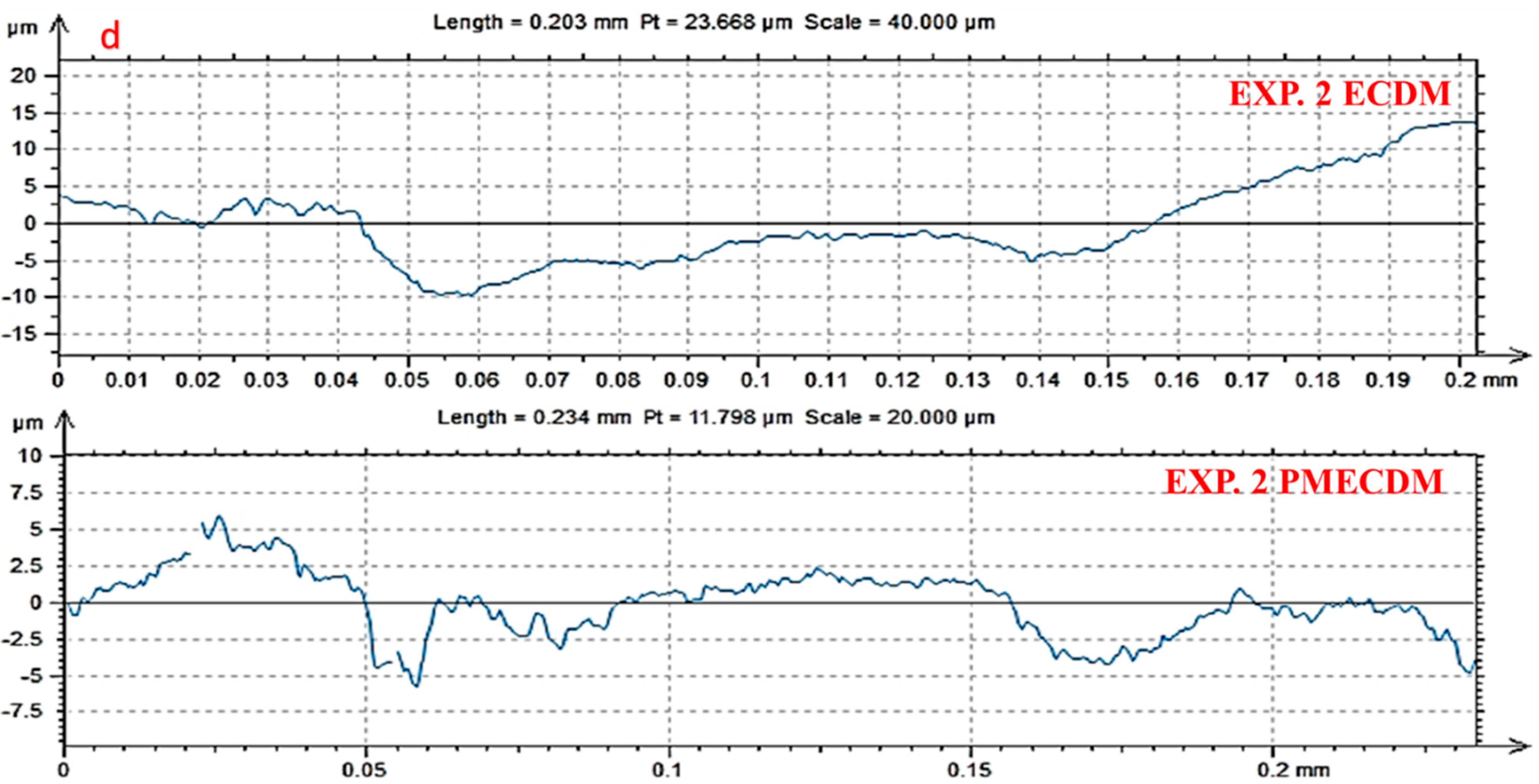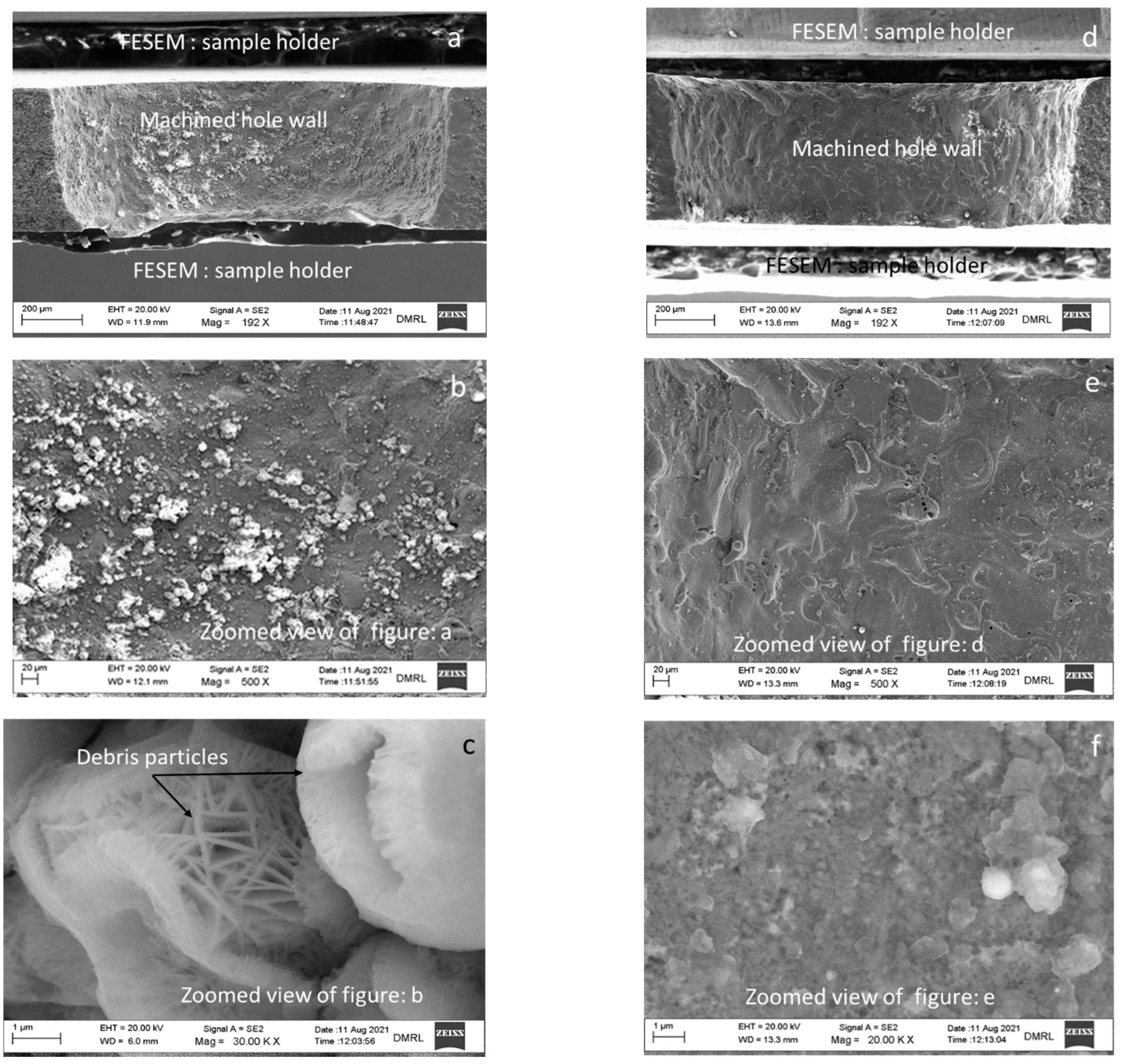Comparison of Maraging Steel Surface Integrity in Hybrid and Conventional Micro-ECDM Processes
Abstract
:1. Introduction
2. Materials and Methods
2.1. Setup Configuration for Experiments
2.2. Material Specifications
2.3. Material Removal Mechanism
2.4. Design of Experiments
2.5. Experimentation and Characterization Techniques
2.6. Regression Modelling
2.6.1. ANOVA Analysis
2.6.2. Regression Equations
3. Result and Discussions
3.1. Effect of Input Parameters on MRR
3.2. Effect of Input Parameters on SR
3.3. Surface Topography
3.4. Microstructure
3.5. Microhardness
3.6. Residual Stress Analysis
4. Conclusions
- The hybridization of the MECDM process can be performed easily by mixing powder additive(s) with the electrolyte, which makes the process more efficient without any modification to the setup.
- High MRR, low average surface roughness, and minimum accumulation of debris on the hole wall was observed in the PMECDM process.
- In the PMECDM process, the highest MRR achieved was 2.44 mg/min with input parameters of 50V, duty factor: 30% and electrolyte concentration: 15 wt% whereas the lowest average surface roughness was obtained with machining parameters of 40V, duty factor: 25% and electrolyte concentration: 15%.
- The mixing of 1 wt% Al2O3 powder to the NaOH (aq.) electrolyte in the PMECDM process leads to an average increase in MRR by 34% and a reduction in average surface roughness by 21% as compared to the MECDM process.
- The grinding action of the abrasives in PMECDM helps enhance the MRR and minimize the SR without compromising the other surface properties.
- The holes fabricated with the PMECDM process had the lowest residual stress (−128.3 ± 3.85 MPa) as compared to MECDM (−200.7 ± 6.02 MPa) and the base material (−341.04 ± 10.24 MPa), which is beneficial for the service life of the component. However, further improvement to the surface integrity can be carried out by fine-tuning the experimental process parameters and by altering the particle size, concentration and type of powders.
Author Contributions
Funding
Institutional Review Board Statement
Informed Consent Statement
Data Availability Statement
Acknowledgments
Conflicts of Interest
References
- Bhukya, R.; Rao, C.S.P.; Rao, G.V. Evaluation and comparison of Machinability characteristics of Maraging Steel and AISI 304 Steels. In Proceedings of the 5th International & 26th All India Manufacturing Technology, Design and Research Conference (AIMTDR 2014), Assam, India, 12–14 December 2014; pp. 1–7. [Google Scholar]
- Kumar, N.; Mandal, N.; Das, A.K. Micro-machining through electro-chemical discharge processes: A review. Mater. Manuf. Process. 2020, 35, 363–404. [Google Scholar] [CrossRef]
- Jha, N.K.; Singh, T.; Dvivedi, A.; Rajesha, S. Experimental investigations into triplex hybrid process of GA-RDECDM during subtractive processing of MMC’s. Mater. Manuf. Process. 2019, 34, 243–255. [Google Scholar] [CrossRef]
- Walia, A.S.; Srivastava, V.; Rana, P.S.; Somani, N.; Gupta, N.K.; Singh, G.; Pimenov, D.Y.; Mikolajczyk, T.; Khanna, N. Prediction of Tool Shape in Electrical Discharge Machining of EN31 Steel Using Machine Learning Techniques. Metals 2021, 11, 1668. [Google Scholar] [CrossRef]
- Bian, J.; Ma, B.; Liu, X.; Qi, L. Experimental Study of Tool Wear in Electrochemical Discharge Machining. Appl. Sci. 2020, 10, 5039. [Google Scholar] [CrossRef]
- Rashedul, I.M.; Zhang, Y.; Zhou, K.; Wang, G.; Xi, T.; Ji, L. Influence of Different Tool Electrode Materials on Electrochemical Discharge Machining Performances. Micromachines 2021, 12, 1077. [Google Scholar] [CrossRef] [PubMed]
- Kumar, N.; Mandal, N.; Das, A.K. Machining of micro features through µ-ECSM process and evaluation of surface integrity. CIRP J. Manuf. Sci. Technol. 2022, 36, 45–56. [Google Scholar] [CrossRef]
- Xu, K.; Zhang, Z.; Yang, J.; Zhu, H.; Fang, X. Experimental study on machining engineering ceramics by electrochemical discharge compound grinding. Materials 2019, 12, 2514. [Google Scholar] [CrossRef] [Green Version]
- Kang, X.; Tang, W. Micro-Drilling in Ceramic-Coated Ni-Superalloy by Electrochemical Discharge Machining. J. Mater. Process. Technol. 2018, 255, 656–664. [Google Scholar] [CrossRef]
- Elhami, S.; Razfar, M.R. Effect of ultrasonic vibration on the single discharge of electro-chemical discharge machining. Mater. Manuf. Process. 2018, 33, 444–451. [Google Scholar] [CrossRef]
- Rattan, N.; Mulik, R.S. Improvement in material removal rate (MRR) using magnetic field in TW-ECSM process. Mater. Manuf. Process. 2017, 32, 101–107. [Google Scholar] [CrossRef]
- Singh, T.; Dvivedi, A.; Shanu, A.; Dixit, P. Experimental investigations of energy channelization behavior in ultrasonic assisted electro-chemical discharge machining. J. Mater. Process. Technol. 2021, 293, 117084. [Google Scholar] [CrossRef]
- Ho, C.C.; Wu, D.S. Characteristics of the arcing plasma formation effect in spark-assisted chemical engraving of glass, based on machine vision. Materials 2018, 11, 470. [Google Scholar] [CrossRef] [Green Version]
- Liu, Y.; Zhang, C.; Li, S.; Guo, C.; Wei, Z. Experimental study of micro electrochemical discharge machining of ultra-clear glass with a rotating helical tool. Processes 2019, 7, 195. [Google Scholar] [CrossRef] [Green Version]
- Han, M.S.; Min, B.K.; Lee, S.J. Improvement of Surface Integrity of Electro-Chemical Discharge Machining Process Using Powder-Mixed Electrolyte. J. Mater. Process. Technol. 2007, 191, 224–227. [Google Scholar] [CrossRef]
- Yang, C.T.; Song, S.L.; Yan, B.H.; Huang, F.Y. Improving machining performance of wire electro-chemical discharge machining by adding SiC abrasive to electrolyte. Int. J. Mach. Tools Manuf. 2006, 46, 2044–2050. [Google Scholar] [CrossRef]
- Kuo, K.Y.; Wu, K.L.; Yang, C.K.; Yan, B.H. Effect of Adding Sic Powder on Surface Quality of Quartz Glass Microslit Machined by WECDM. Int. J. Adv. Manuf. Technol. 2015, 78, 73–83. [Google Scholar] [CrossRef]
- Elhami, S.; Razfar, M.R. Application of nano electrolyte in the electro-chemical discharge machining process. Precis. Eng. 2020, 64, 34–44. [Google Scholar] [CrossRef]
- Huang, S.F.; Liu, Y.; Li, J.; Hu, H.X.; Sun, L.Y. Electrochemical discharge machining micro-hole in stainless steel with tool electrode high-speed rotating. Mater. Manuf. Process. 2014, 29, 634–637. [Google Scholar] [CrossRef]
- Kulkarni, A.V.; Jain, V.K.; Misra, K.A. Electrochemical spark micromachining (microchannels and microholes) of metals and non-metals. Int. J. Manuf. Technol. Manag. 2011, 22, 107–123. [Google Scholar] [CrossRef]
- Coteaţă, M.; Schulze, H.P.; Pop, N.; Beşliu, I.; Slătineanu, L. Machinability of a stainless steel by electro-chemical discharge microdrilling. AIP Conf. Proc. 2011, 1353, 1356–1360. [Google Scholar] [CrossRef]
- Shi, X.; Huang, S.; Wang, L. Investigation of the material removal mechanism in electro-chemical discharge drilling using a high-speed rotating helical tool-electrode. Int. J. Electrochem. Sci. 2019, 14, 9239–9254. [Google Scholar] [CrossRef]
- Singh, T.; Dvivedi, A. On pressurized feeding approach for effective control on working gap in ECDM. Mater. Manuf. Process. 2018, 33, 462–473. [Google Scholar] [CrossRef]
- Bai, Y.; Zhao, C.; Yang, J.; Hong, R.; Weng, C.; Wang, H. Microstructure and machinability of selective laser melted high-strength Maraging steel with heat treatment. J. Mater. Processing Technol. 2021, 288, 116906. [Google Scholar] [CrossRef]
- Kolhekar, K.R.; Sundaram, M. Study of gas film characterization and its effect in electro-chemical discharge machining. Precis. Eng. 2018, 53, 203–211. [Google Scholar] [CrossRef]
- Rathore, R.S.; Dvivedi, A. Sonication of tool electrode for utilizing high discharge energy during ECDM. Mater. Manuf. Process. 2020, 35, 415–429. [Google Scholar] [CrossRef]
- Behroozfar, A.; Razfar, M.R. Experimental and numerical study of material removal in electro-chemical discharge machining (ECDM). Mater. Manuf. Process. 2016, 31, 495–503. [Google Scholar] [CrossRef]
- Kumar, N.; Das, A.K. Micro-channel fabrication on GFRP composite through electrochemical spark machining method and optimization of process parameters. Proc. Inst. Mech. Eng. Part B J. Eng. Manuf. 2022, 3, 09544054221093302. [Google Scholar] [CrossRef]
- Kumar, N.; Bishwakarma, H.; Sharma, P.; Singh, P.K.; Das, A.K. Optimization of Process Parameters in Micro-Electrochemical Discharge Machining by Using Grey Relational Analysis. Mater. Sci. Forum 2020, 978, 121–132. [Google Scholar] [CrossRef]
- Chandrashekarappa, M.P.; Kumar, S.; Pimenov, D.Y.; Giasin, K.; Jagadish, J. Experimental analysis and optimization of EDM parameters on HcHcr steel in context with different electrodes and dielectric fluids using hybrid taguchi-based PCA-utility and CRITIC-utility approaches. Metals 2021, 11, 419. [Google Scholar] [CrossRef]
- Kumar, N.; Mandal, N.; Das, A.K. Microelectrochemical sparks machining: A modern approach for fabrication of microcomponents from non-conductive materials. In Micro Electro-Fabrication; Elsevier: Amsterdam, The Netherlands, 2021; pp. 277–315. [Google Scholar] [CrossRef]
- Pawariya, K.; Dvivedi, A.; Singh, T. On performance enhancement of electro-chemical discharge trepanning (ECDT) process by sonication of tool electrode. Precis. Eng. 2019, 56, 8–19. [Google Scholar] [CrossRef]
- Varghese, A.; Paul, L. Effect of Powder Mixed Electrolyte in ECDM Process. Mater. Today Proc. 2018, 5, 11864–11869. [Google Scholar] [CrossRef]
- Kumar, A.; Mandal, A.; Dixit, A.R.; Das, A.K.; Kumar, S.; Ranjan, R. Comparison in the performance of EDM and NPMEDM using Al2O3 nanopowder as an impurity in DI water dielectric. Int. J. Adv. Manuf. Technol. 2019, 100, 1327–1339. [Google Scholar] [CrossRef]
- Zhang, C.; Xu, Z.; Zhang, X.; Zhang, J. Surface integrity of holes machined by electro-chemical discharge drilling method. CIRP J. Manuf. Sci. Technol. 2020, 31, 643–651. [Google Scholar] [CrossRef]












| Exp. No. | Voltage (V) | Duty Cycle (D) | Concentration (% wt.) | Micro-ECDM | PMECDM | ||
|---|---|---|---|---|---|---|---|
| MRR (mg/min) | SR (µm) | MRR (mg/min) | SR (µm) | ||||
| 1 | 40 | 25 | 15 | 0.853 | 0.737 | 1.339 | 0.567 |
| 2 | 50 | 25 | 20 | 1.236 | 1.240 | 2.160 | 0.965 |
| 3 | 40 | 30 | 20 | 1.168 | 0.793 | 2.019 | 0.670 |
| 4 | 40 | 20 | 10 | 0.502 | 0.819 | 0.791 | 0.670 |
| 5 | 40 | 25 | 15 | 0.877 | 0.723 | 1.360 | 0.581 |
| 6 | 50 | 25 | 10 | 0.997 | 1.161 | 1.706 | 0.856 |
| 7 | 40 | 20 | 20 | 0.719 | 0.793 | 0.898 | 0.690 |
| 8 | 50 | 30 | 15 | 1.297 | 1.097 | 2.438 | 0.820 |
| 9 | 30 | 25 | 20 | 0.817 | 1.012 | 1.301 | 0.801 |
| 10 | 50 | 20 | 15 | 0.819 | 1.198 | 1.104 | 0.877 |
| 11 | 30 | 20 | 15 | 0.580 | 0.933 | 0.752 | 0.797 |
| 12 | 30 | 25 | 10 | 0.520 | 0.952 | 0.789 | 0.756 |
| 13 | 30 | 30 | 15 | 0.710 | 0.913 | 0.895 | 0.697 |
| 14 | 40 | 30 | 10 | 0.833 | 0.742 | 1.323 | 0.587 |
| 15 | 40 | 25 | 15 | 0.882 | 0.743 | 1.380 | 0.579 |
| Source | DF | Adj SS | Adj MS | F-Value | p-Value |
|---|---|---|---|---|---|
| Model | 9 | 0.8092 | 0.8991 | 94.33 | 0.000 |
| Linear | 3 | 0.7585 | 0.2528 | 265.24 | 0.000 |
| Square | 3 | 0.0162 | 0.0054 | 5.66 | 0.046 |
| 2-way interaction | 3 | 0.0346 | 0.0115 | 12.09 | 0.010 |
| Error | 5 | 0.0047 | 0.0009 | ||
| Lack-of-fit | 3 | 0.0043 | 0.0014 | 6.17 | 0.143 |
| Pure error | 2 | 0.0004 | 0.00023 | ||
| Total | 14 | 0.8139 |
| Source | DF | Adj SS | Adj MS | F-Value | p-Value |
|---|---|---|---|---|---|
| Model | 9 | 3.8665 | 0.4296 | 221.61 | 0.000 |
| Linear | 3 | 3.3014 | 1.1005 | 567.67 | 0.000 |
| Square | 3 | 0.1228 | 0.0409 | 21.12 | 0.003 |
| 2-way interaction | 3 | 0.4423 | 0.14743 | 76.05 | 0.000 |
| Error | 5 | 0.0096 | 0.00194 | ||
| Lack-of-fit | 3 | 0.0088 | 0.00296 | 7.15 | 0.125 |
| Pure error | 2 | 0.0008 | 0.00041 | ||
| Total | 14 | 3.8763 |
| Source | DF | Adj SS | Adj MS | F-Value | p-Value |
|---|---|---|---|---|---|
| Model | 9 | 0.4544 | 0.0504 | 118.49 | 0.000 |
| Linear | 3 | 0.1063 | 0.0354 | 83.21 | 0.000 |
| Square | 3 | 0.2448 | 0.1149 | 269.77 | 0.000 |
| 2-way interaction | 3 | 0.0031 | 0.0010 | 2.49 | 0.175 |
| Error | 5 | 0.0021 | 0.0004 | 6.30 | |
| Lack-of-fit | 3 | 0.0019 | 0.0006 | 0.140 | |
| Pure error | 2 | 0.0002 | 0.0001 | ||
| Total | 14 | 0.4565 |
| Source | DF | Adj SS | Adj MS | F-Value | p-Value |
|---|---|---|---|---|---|
| Model | 9 | 0.2115 | 0.0235 | 93.26 | 0.000 |
| Linear | 3 | 0.0439 | 0.0146 | 58.16 | 0.000 |
| Square | 3 | 0.1650 | 0.0550 | 218.34 | 0.000 |
| 2-way interaction | 3 | 0.0024 | 0.0008 | 3.28 | 0.117 |
| Error | 5 | 0.0012 | 0.0002 | ||
| Lack-of-fit | 3 | 0.0011 | 0.0003 | 6.66 | 0.133 |
| Pure error | 2 | 0.0001 | 0.0000 | ||
| Total | 14 | 0.2127 |
Publisher’s Note: MDPI stays neutral with regard to jurisdictional claims in published maps and institutional affiliations. |
© 2022 by the authors. Licensee MDPI, Basel, Switzerland. This article is an open access article distributed under the terms and conditions of the Creative Commons Attribution (CC BY) license (https://creativecommons.org/licenses/by/4.0/).
Share and Cite
Mandal, N.; Hloch, S.; Das, A.K. Comparison of Maraging Steel Surface Integrity in Hybrid and Conventional Micro-ECDM Processes. Materials 2022, 15, 4378. https://doi.org/10.3390/ma15134378
Mandal N, Hloch S, Das AK. Comparison of Maraging Steel Surface Integrity in Hybrid and Conventional Micro-ECDM Processes. Materials. 2022; 15(13):4378. https://doi.org/10.3390/ma15134378
Chicago/Turabian StyleMandal, Niladri, Sergej Hloch, and Alok Kumar Das. 2022. "Comparison of Maraging Steel Surface Integrity in Hybrid and Conventional Micro-ECDM Processes" Materials 15, no. 13: 4378. https://doi.org/10.3390/ma15134378






